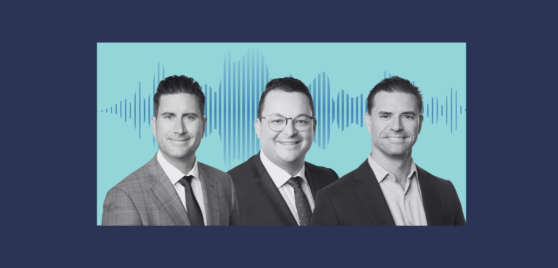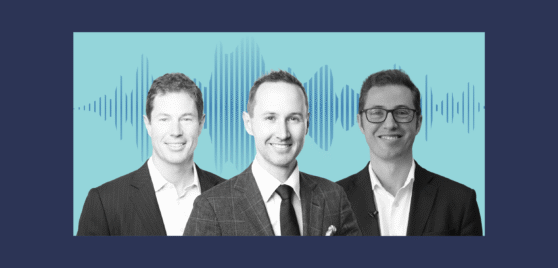Featuring Simon Conn
LISTEN
READ
In the second in a special series of reporting season podcasts, Simon Conn, IML Senior Portfolio Manager in the small-mid cap team chats to Jason Guthrie, about his main takeaways from Reporting Season so far, including an update on the small-mid cap sector, as well as the results from four key stocks
- Amotiv (ASX:AOV), formerly GUD
- Ansell (ASX: ANN)
- Ampol (ASX: ALD)
- Hansen Technologies (ASX: HSN)
Follow our podcast, ‘Navigating the Noise’ on Spotify, Apple or Amazon to be notified of new episodes.
 |
 |
 |
Lightly edited transcript – recorded on 21 August.
Jason Guthrie: Hello and welcome to Navigating the Noise, a podcast by Natixis Investment Managers Australia, where we bring you insights from our global collective of experts to help you make better investment decisions. I’m your host, Jason, Head of Wholesale and today, we’ve got a couple of special reporting season episodes where we’re joined by the Investment Team at IML. I mentioned in the last episode, I’ve been in the Sydney office earlier this week, and there’s been a bunch of management teams rolling through the IML doors there, so today is a timely update to run through some of the key themes and how the companies are performing in the IML portfolios. In this episode, we’re joined by IML’s Small Cap senior portfolio manager, Simon. Welcome, Simon. Always great to have you back on the podcast.
Simon Conn: Thanks, Jason. Thanks for having me again.
Jason: I understand a lot of the smaller companies in Australia are still yet to report a little bit later than the large cap guys we caught up with earlier, so it is a bit early to cover the whole market in certain sectors. But how are you seeing things so far and in particular, what are some of the key themes and messages coming from the reports and some of the management teams you have spoken to today?
Simon: Yeah. I’m going to have to say, Jason, initially most of the results have been, I think, much better or better than feared. I think Australian corporates are still in pretty good health, to be frank. Obviously a lot of concern was around the consumer coming into reporting season, and we’ve seen, I think, for the results today that the consumers managed to trade through a pretty difficult period in terms of higher cost of living, and there’s been some relief coming through with cost of goods sold from the retailers, and that to date top lines have been actually quite reasonable, so better than feared. I think the highlights for me has been gross margin performance across the board, and operating cash flows have been very strong. So we’ve seen some companies being able to print good cash flows and reduce their balance sheet positions, being able to reduce their debt, which is flying back into the odd dip buyback and better dividend outlooks, I think.
Jason: So certainly it seems a bit of a similar story to what the large cap guys are seeing, and it does feel and sound like the economy’s performing pretty well, despite this stubborn and persistent inflation and a higher-rate environment we’re in. And if we turn to the performance of the small cap funds, how are things going there? It’s always best going through the actual individual companies, so it would be great to touch on some of the more specific names and the results that you’ve seen.
Simon: Thanks, Jason. Look, obviously the small cap market’s much more varied in terms of sector exposure than the large cap guys, but we’ve seen some solid results. One particular, Amotiv (ASX:AOV), which was previously known as GUD, they’ve just renamed themselves, but really in line with what I was saying before, we saw sales growth of about 4 or 5%. The company was able to hold their cogs (Cost of Goods Sold) and actually grow their gross margins. That business has generated really strong cash flow. So on top of the asset sale of Davey, they did during the half, they’ve managed to reduce their gearing down net debt to EBITDA 1.6 times. So you remember a couple of years ago this company geared up to buy a company called AutoPacific Group to expand their portfolio into the four wheel drive accessories market. And that business, whilst it’s still below the investment case, has been able to grow as we’ve seen increased car supplies coming back into the country.
So stock’s on 12 times, yield’s 4%. Really good management team. They’ve set the balance sheet up now, I think for small bolt-on acquisitions, and ARB continues to show that that category is very resilient. It continues to generate high gross margins, and we think the business can continue to generate reasonable earnings growth and pay a good yield going forward, and at 12 times we think it looks really, really attractively priced. So, for ours, that’s the much cheaper version of four-wheel drive after-market accessories than ARB which trades at a much higher multiple.
Jason: So the name change, what was that? Do you know why that happened?
Simon: That really just reflects the changing nature of the business. GUD was a bit of a mini conglomerate, and Davey was their last non-automotive related asset. And a couple of years ago they had a reset of the strategy and decided to focus on the automotive aftermarket and repair market.
Jason: Right. What else is jumping out at you?
Simon: Ansell, that’s a stock we know very well. We’ve owned that in the past, and it’s a stock that we think made a really significant acquisition in Kimberly-Clark in the healthcare sector earlier this calendar year. They raised capital at $22.45, and we participated in the raise and bought more stock. Following that capital raising, stock’s just under $30 today, so it’s been a good performer for us, really good management team who seem really invigorated.
This was a business that really got knocked around in Covid. You remember one of the businesses when everyone was buying what they call PPE or gloves and protective equipment, it had a booming result and then got left with the hangover as a lot of stock was in the inventory channels in their customers and distributors. So, it’s taken a long time for that inventory to wash through the system, but the second half result shows in the healthcare division that the destocking’s ended and so that now things are starting to normalise, which means that their second half result was better, and I think the outlook for their healthcare business into 25 is much better.
And you add to that the Kimberly-Clark business, and that was their nearest competitor in that hand and body protection market. I think the stock’s had a good run, but it’s still on 18 times next year, which is not overly expensive for a business we think can continue to grow. And a company that generally tends to generate much more cash than earnings, and they’re in the middle of a CapEx cycle. By the end of 25, they will have completed a big Indian manufacturing facility, and then CapEx will decline and cashflow generation will improve. And we think with the synergies coming through from Kimberly-Clark, that sets them up for a very good couple of years.
Jason: Something a little bit different. I think they reported today, is it Hansen Technologies?
Simon: Absolutely. So what’s happening is a real electrification of the grid, and people are talking about virtual power stations, people linking solar on their roof with gas backup or hydro. So really a lot of the energy companies are now building virtual grids and having to real-time trade electrons as the electricity price moves and the source of energy generation moves with the grids becoming increasingly integrated. But interestingly I went to the AGL lunch and they talked about three leading software platforms globally. Octopus obviously in the UK and Australia, which is aligned with Origin, there’s Kaluza out of Japan, which Origin are now bringing to Australia and the third one is a company called powercloud. Now, powercloud has a large market position in Germany, and it’s a business that Hansen acquired about 12 months ago. Now, powercloud got into some trouble and expanded too rapidly under private equity ownership, and the vendor of that business, the private equity firm, looked to exit and the company was losing money at the time.
And so the Hansen team, as they’ve done many times, have bought a business which they’re really going to strip back to the core and focus on their core expertise. Importantly, Hansen already operate in Germany, they’ve got a leading telco services software platform. So Hansen is a global business in terms of software billing and procurement software. Really, they run the billing engines for a lot of electricity companies around the world, and it flies below the radar, but it’s been a very successful business growing through acquisitions of mature technology businesses. But look, the result today was I think solid result and taken well because their core cash EBITDA was up 11%. They were able to grow their top line 6 to 8%. And a lot of the businesses Hansen have had in the past have been quite mature, but I think powercloud and some other acquisitions they’ve made seem to reposition the business back into more of growth markets.
And we think there’s just a huge opportunity in powercloud given the low penetration of renewables today in Germany, but the big pipeline that the German government has in terms of rolling out renewables into that market and a lot of the market hasn’t adopted the technology platforms. And the other factor in play is that SAP are pulling out of the sector, so they’re not investing in the next generation of technology required to run these virtual power grids, and that positions powercloud very well in the German market, we believe, to generate good growth.
So it’s founder led, Andrew Hansen’s run the business for a long period of time, and going back many years we owned it below a dollar, and it was a good performer for us for many years. And so we’ve tipped our toe back in the water over the last six months with the stock coming back. Look, it’s very reasonably priced, and we think it’s quite well positioned. It’s got a very cash-rich balance sheet, so not much debt at all, which sets the balance sheet up to fund further acquisitions going forward. So, one we really like, and I think on any weakness we’d be happy to add to that position as well.
Jason: Sounds like a cracking business
Simon: Yeah. Look, really under-appreciated.
Jason: Anything that hasn’t gone to plan? Anything you want to highlight?
Simon: Yeah, obviously people are aware that Ampol is one that, it’s been a big holding in the fund, one that ran earlier in the year and we trimmed that weight back, but it’s still a largeish holding in the fund and their result earlier this week was a bit disappointing. The disappointment really came around the more cyclical parts of their business. People obviously aware that they’re one of two refiners in the country, so they run the Lytton fuel refinery up in Queensland and they also have a trading business, which is really about hedging their requirements into Australia, and they manage to make a margin on that. But what we’ve witnessed over the last six months is that refining margins have been pretty benign and there’s also actually perversely, despite all the issues in the Middle East, the trading margins have been quite soft because there’s been not much dislocation in the market. So, both those businesses had soft results.
The core fuel and infrastructure distribution, the convenience retail business, their newish acquisition of Z Energy in New Zealand, all those core businesses that are more annuity like, all performed very solidly, despite the headwinds of a tough consumer environment. But their more cyclical business of refining and trading had softer outcomes, and so the result was held back by that. They also announced at the result that CapEx would be higher for the next 12 to 18 months with some shuts in the refinery and then upgrades to the low-sulphur fuel requirements. So they flagged higher CapEx, which means that the dividend will be lower over the next 12 to 18 months.
We’re meeting with them in the next couple of days, so we’ve obviously got to size that, but in our estimates it’s still on about a 5% fully franked yield whilst assuming that these two more volatile earning streams stay depressed for a while. So it’s still an attractive yield, but obviously not as high potentially as we expect, but given the volatility we’re seeing in the geopolitical environment, we know that markets can always be volatile as we witnessed at the beginning of this month, I wouldn’t bet against seeing some volatility and those earning streams recovering at some point in the next 6 to 12 months. So, you know, 12 and a half times, yield of five, looks very cheaply priced and one that we’ve been adding to on weakness.
Jason: And I guess, Simon, just more broadly, we are seeing more interest and increased demand from investors potentially looking to rotate some capital into smalls. Are you still seeing that gap, that dispersion between large and small cap valuations in the Aussie market?
Simon: Yeah. Look, I think things like Hansen and Ampol, Amotiv, these are 12, 13 times PEs, they’re not that expensive. And what we have witnessed is that flash crash we had at the beginning of this month where we saw a massive correction in the markets, small caps got sold off very heavily and I think if you look at the small ords, it fell back to a level where it was trading maybe late January, early February. The ASX 200, the broader market really only gave up a couple of months of gains. So, unfortunately we gave up quite a bit of the gains there, and the market really remains quite bifurcated at the small cap end. So we’re seeing big price moves by a lot of growthy stocks, by PE stocks that are re-rating, and yet there’s still a lot of good value in this sector of the market.
And what’s coming through in reporting season is this position in Australia is actually not too bad. Unemployment remains low. The consumer has, at the high end of those people who retired dipping into their savings, they’re getting positive returns on their term deposits and the like. And government continues to pull a lot of money into the economy. We’ve had the tax cuts come through, so there’s a bit of stimulus there. And the economy, it’s chugging along okay, Jason. I think things aren’t nearly as bad as people might’ve feared.
Jason: Fantastic. All right, we might wrap it up there. Thanks again, Simon. Always great to have you on the podcast. I know things are really starting to heat up there for the team on the small cap side, so appreciate you jumping on to provide a quick update to our clients. Thank you, of course, to our listeners. If you enjoyed the episode, please click follow on your podcast platform, and tune in again very soon to hear more from our global collective of experts.
Disclaimer
This podcast has been prepared and distributed by Natixis Investment Managers Australia Proprietary Limited, ABN 60 088 786 289, AFSL 246830 and includes information provided by third parties, including Investors Mutual Limited (“IML”) AFSL 229988, the responsible entity and investment manager for the IML Funds.
Although Natixis Investment Managers Australia believes that the material in this podcast is correct, no warranty of accuracy, reliability, or completeness is given, including for information provided by third parties except for liability under statute which cannot be excluded. This material is not personal advice. The material is for general information only and does not take into account your personal objectives, financial situation or needs. You should consider and consult with your professional advisor whether the information is suitable for your circumstances. The opinions expressed in the materials are those are the speakers and may not necessarily be those of Natixis Investment Managers Australia or its affiliate investment managers. Before deciding to acquire or continue to hold an investment in a fund, you should consider the information contained in the product disclosure statement in conjunction with the target market determination, TMD, available at www.stg-imlimited-staging.kinsta.cloud.
Past investment performance is not a reliable indicator of future investment performance and no guarantee of performance, return of capital, or a particular rate of return is provided. Any mention of specific company names, securities or asset classes is strictly for informational purposes only and should not be taken as a recommendation to buy, hold, or sell. Any commentary about specific securities is within the context of the investment strategy for the given portfolio. The material may not be reproduced, distributed, or published in whole or in part without the prior written consent of Natixis Investment Managers Australia. Copyright 2024 Natixis investment Managers Australia. All rights reserved.
INVESTMENT INSIGHTS & PERFORMANCE UPDATES
Subscribe to receive IML’s regular performance updates, invitations to webinars as well as regular insights from IML’s investment team, featured in the Natixis Investment Managers Expert Collective newsletter.
IML marketing in Australia is distributed by Natixis Investment Managers, a related entity. Your subscriber details are being collected by Natixis Investment Managers Australia, on behalf of IML. Please refer to our Privacy Policy. Natixis Investment Managers Australia Pty Limited (ABN 60 088 786 289) (AFSL No. 246830) is authorised to provide financial services to wholesale clients and to provide only general financial product advice to retail clients.





